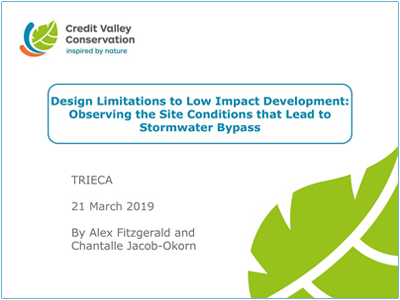TRACK 1
Design Limitations to LID: Observing the Site Conditions that Lead to Stormwater Bypass
ABSTRACT
Low impact development (LID)/green infrastructure plays a crucial role in water quality protection by limiting pollutant loading, and in stream protection by reducing peak flows and erosion.
Many types of LID features, such as bioretention, rely on infiltration for stormwater treatment. Under certain conditions, however, stormwater cannot infiltrate quickly enough. It will pond on the bioretention surface, and will either enter an overflow system or bypass the system entirely.
When these bypass and overflow events occur, stormwater runoff is not being treated and is not receiving any of the volume reduction or quality improvements that LIDs provide.
Understanding what types of events produce bypass, and the resulting impact on water quality and quantity performance, is vital for planning and designing LIDs.
Monitoring bypass and overflow events can also be used to inform the type and frequency of maintenance activities.
The parking lot at the IMAX head office in Mississauga contains three bioretention swales with different pre- and post-treatments. For each of these swales, the total outflow volume, height of water in the bioretention system, height of ponded water, and water quality were measured for storm events from 2014 to 2018.
This presentation will present performance data reviewing the factors that cause bypass events, comparing water quality and quantity results between bypass and non-bypass events, and analyzing seasonal patterns that impact the frequency of bypass.
Learning Objectives
1. Assess the factors that lead to overflow and bypass during precipitation events for bioretention systems, including total precipitation depth, precipitation intensity and antecedent conditions
2. Review the impact of bypass and overflow events on the water quality performance of bioretention systems
3. Lessons learned: Approaches to collecting performance data from infiltration and volume storage features in winter months
ABOUT THE PRESENTERS

Alex Fitzgerald
Alex Fitzgerald is a water resource coordinator with Credit Valley Conservation (CVC). His current projects include monitoring low impact development features, such as those located at the IMAX head office, and CVC’s Climate Change Strategy.
Prior to joining CVC in early 2015, Alex completed his M.Sc. at McMaster University, focusing on groundwater-stream interaction, and worked for the Canadian Environmental Assessment Agency.

Chantalle Jacob-Okorn
Chantalle Jacob-Okorn is a water resources technician at Credit Valley Conservation (CVC).
Chantalle conducts low impact development (LID) performance monitoring activities, using various types of monitoring techniques and equipment, as well as various data analysis approaches, to address compliance and performance questions surrounding LID practices.
She is a Master of Environmental Science graduate from the University of Toronto.

